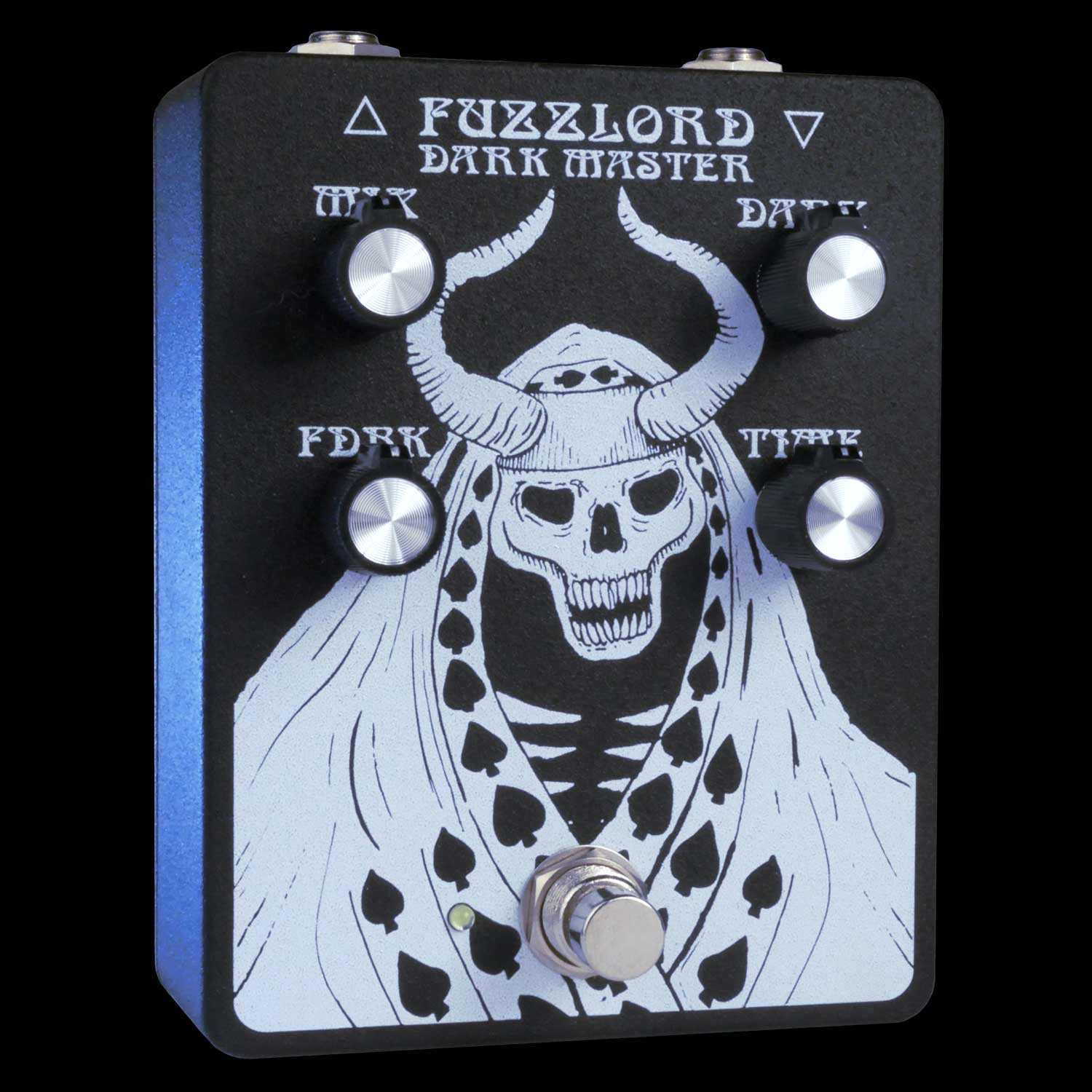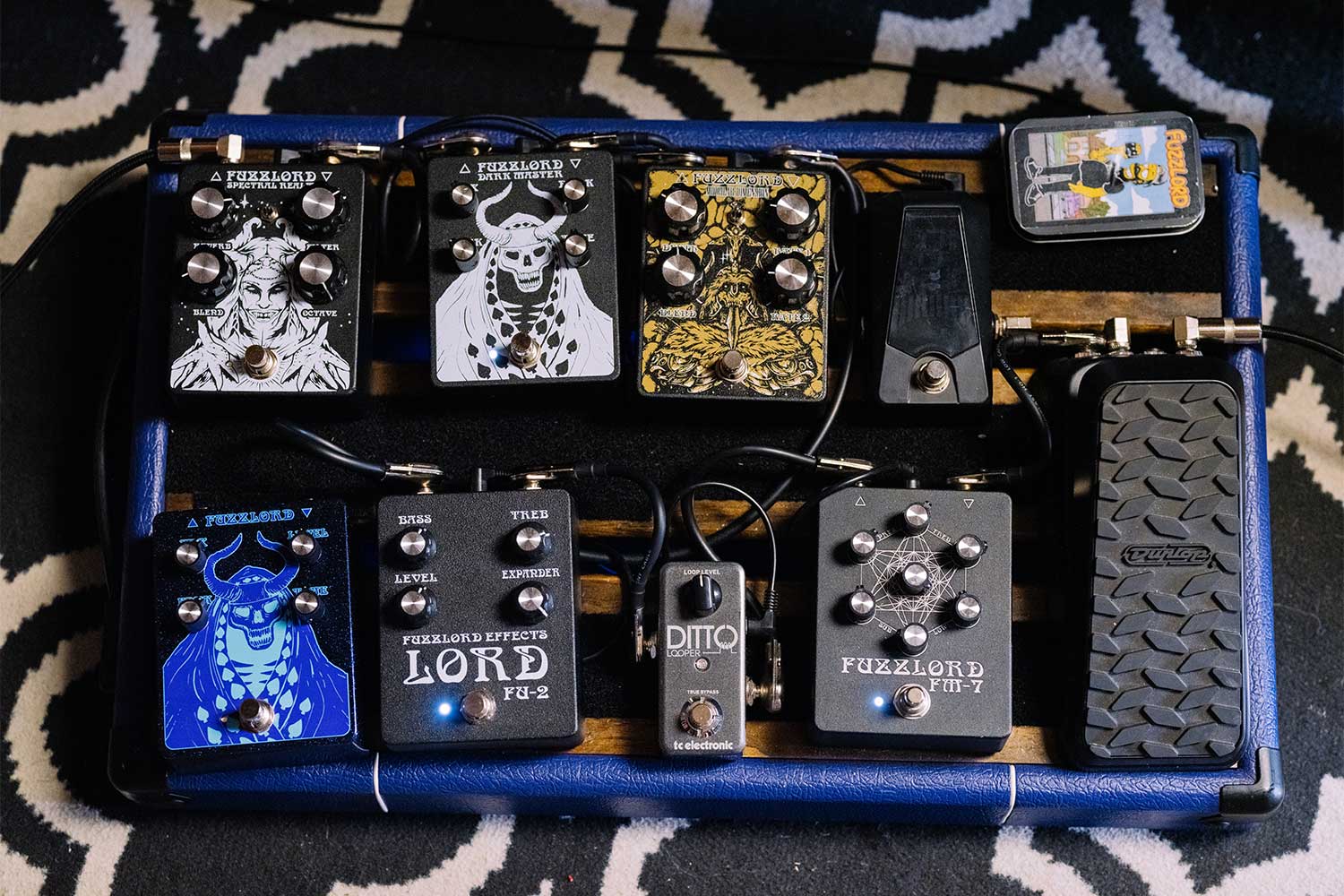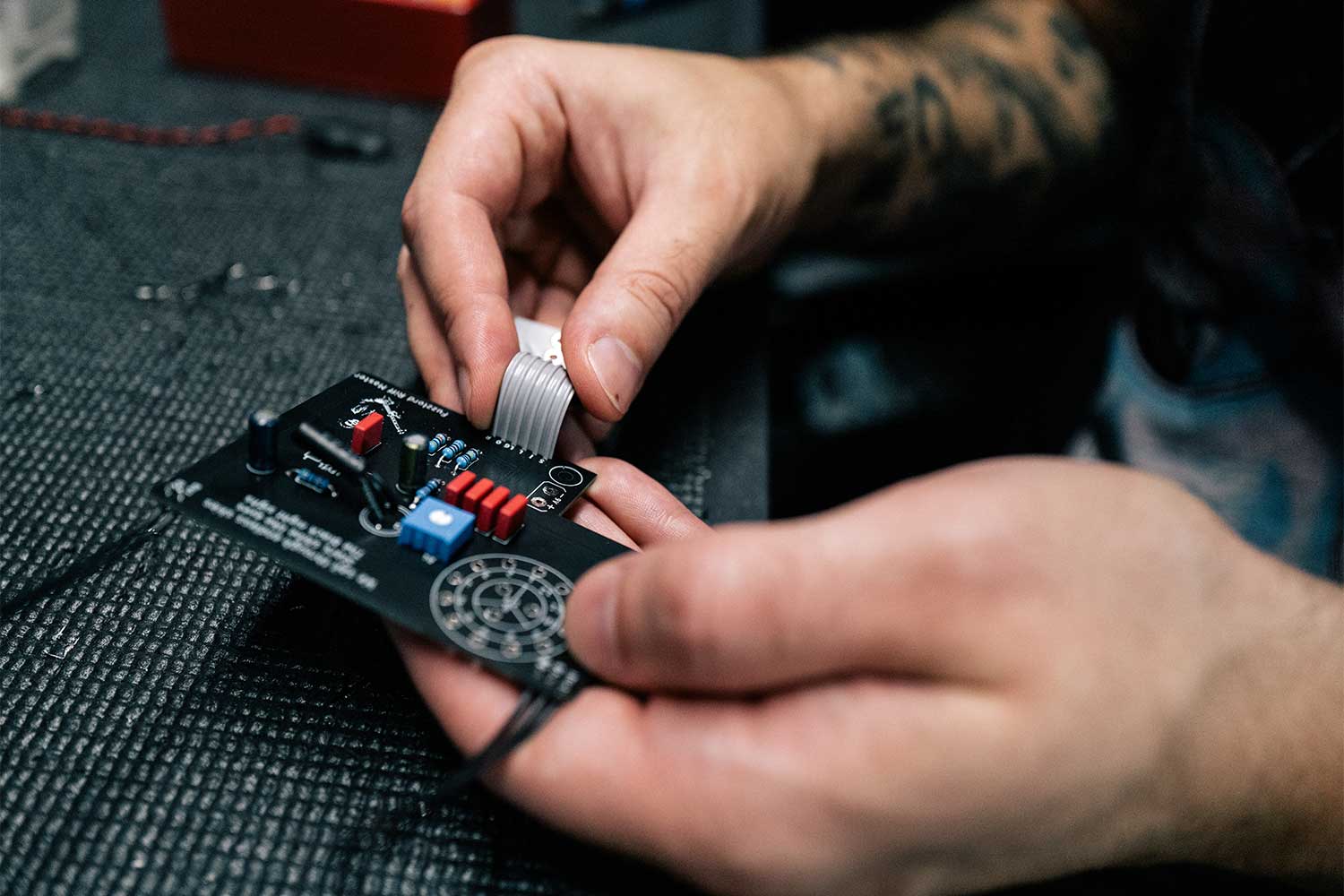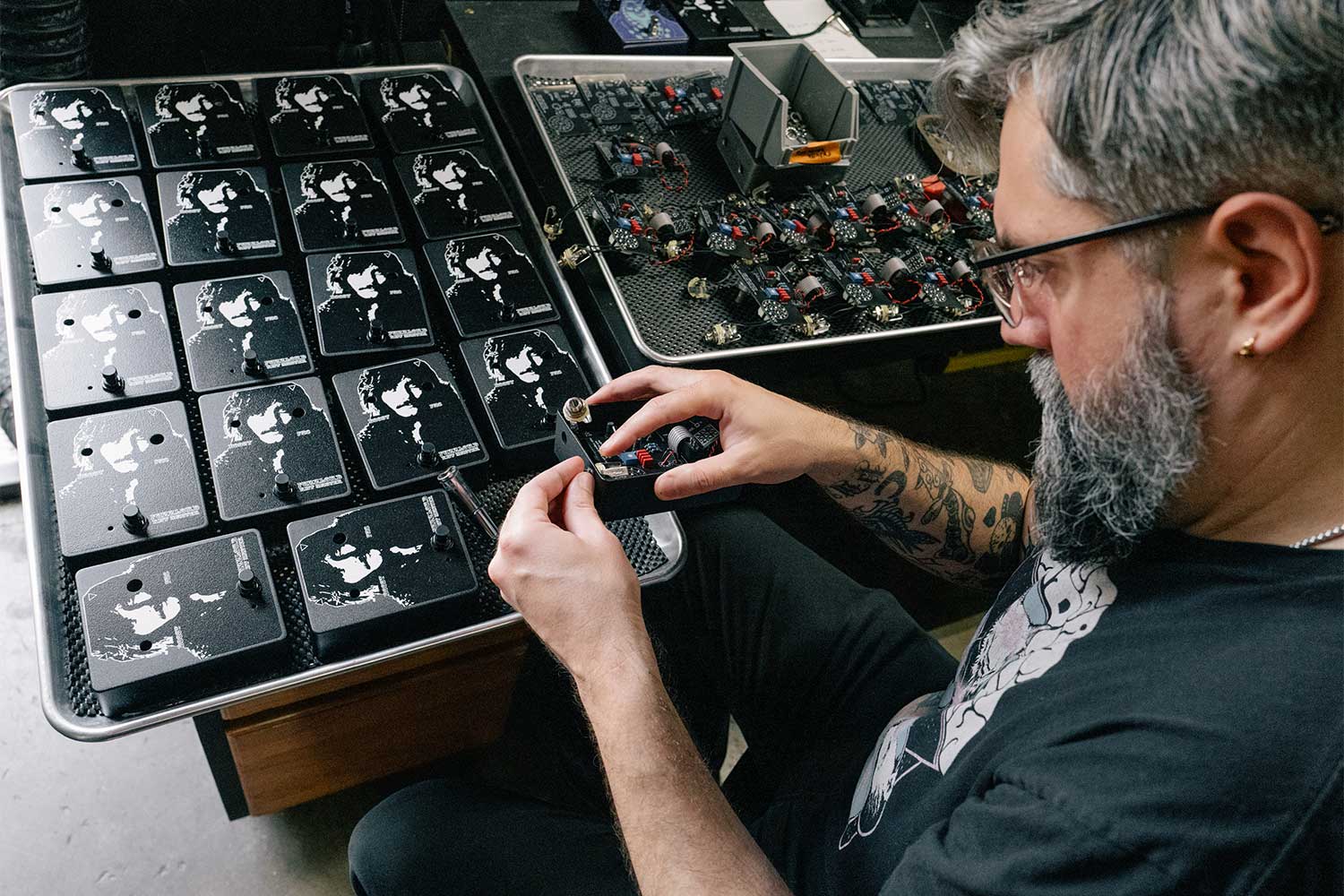Like most good stories, this begins in a grocery store parking lot.
As a guitar player, I’m always looking at guitars and guitar equipment, and that search has led me to an Albertsons parking lot, where I’m trading a Fender reverb pedal with someone I’ve met online who’s willing to part with a Fuzzlord Effects Drone Master distortion pedal.
I spent the night before scrolling through YouTube reviews of the pedal to make sure it’s something I want. What I don’t find out until the trade has been made is that Fuzzlord is based in Eugene. This nugget of information takes me on a trip to a quiet neighborhood in Santa Clara to meet with Jason Johnson, the wizarding mind behind Fuzzlord Effects, a company that has been arming musicians with hand-wired pedals for the past eight years.
Since starting his company, Johnson has earned a reputation among musicians for creating high-quality gear but also investing time on his growing YouTube channel that teaches guitarists how to create pedals and prepare their gear to play doom metal, a subgenre of metal known for its slow tempos and droning, thick sounds with roots going back to Black Sabbath.

“He’s definitely not stingy with his knowledge, but he doesn’t have to just spout it every second,” guitarist and vocalist Mike Scheidt says about Johnson. Scheidt plays with Yob, a doom metal band that’s been recording and touring for the past 25 years.
“He can just be somebody in the room with you, enjoying a sound or talking about a riff or talking about a band, and not necessarily having to just break it all apart every second.”
Pedals allow guitarists to dial in specific tones. The next time you’re at a show, take a look at where the guitarist is standing and you’ll likely see them stomping away at certain parts of the song. Pedals can alter a guitarist’s (or bassist’s) tone to distort, delay, reverberate, boost, meow — and more. The options are endless, and that’s what drives so many guitarists (like myself) to suffer from “gear acquisition syndrome” (aka GAS).

Getting Fuzzy
When Johnson started Fuzzlord in 2016, he focused on distortion and fuzz pedals, inspired by the electronic schematics of rare and out-of-production guitar pedals from the ’60s and ’70s, such as the Univox Super Fuzz pedal, a model that Jimi Hendrix and The Who’s Pete Townsend used in the past.
Fuzz pedals, for example, can be used in different ways. Maybe it’s a wall of sound that booms like a jet that Smashing Pumpkins uses on “Today,” a saxophone-like tone that Keith Richards has in the Rolling Stones’ “(I Can’t Get No) Satisfaction” or the cool warm texture that Hendrix has in “Foxey Lady.”
In more technical terms of how a fuzz pedal works, Johnson breaks down the circuit board as “several transistors running into each other, amplifying the guitar signal. Each stage is driving the next one really hard, and gets more of a square wave if you were to look at the audio signal like on a screen.”
Before he founded Fuzzlord Effects, Johnson says he was unable to find the right tone from guitar pedals he was using. After spending some time making custom order units for buyers, he went back to college to study electrical engineering at Oregon State University. While classmates were likely looking at lucrative careers with Boeing or HP, Johnson was wanting to work for a music company like Fender or Orange. That earned him the nickname of “fuzzbox guy” from one of his professors, he recalls.
Rather than working for one of the more established music gear companies after he graduated in 2017, Johnson devoted his full time focus to Fuzzlord Effects. He started Fuzzlord shortly before his final year, and would sometimes get attention from classmates and instructors while designing guitar pedal schematics in class, he recalls.
The pedal schematic that he would get caught drawing in class would go on to be the company’s first pedal, the FET120, a fuzz distortion pedal modeled after the British-based Orange amplifier from the ’70s.
In the early years of the company, Johnson says, he worked nonstop to hand-wire around 25 to 30 pedals a year. Those would sell out quickly, leaving many people bummed they’d miss out on the pedals when they were in stock, he says. Today, he has another person helping with assembling pedals, helping the company meet the growing demand for pedals.
“It’s been eight years now,” Johnson says. “I don’t see myself stopping anytime soon. I’d be really happy getting a larger team together. I know a lot of people are interested in working with pedals, and I’d feel good about providing more jobs.”
In addition to tone, part of what makes Fuzzlord Effects’ pedals stand out compared to more mainstream gear is the art that goes with the pedals. To match the musical vibes of the ’70s, many of his pedals have artwork that look like they could be characters from Ralph Bakshi’s Wizards or Lord of the Rings movies.
Design and artwork in pedals is important for Fuzzlord Effects, and Johnson says he collaborates with artists around the world. Having interesting design and artwork allows a musician to have a connection with the gear or instrument, he says. Whether you’re playing a Gibson SG because Tony Iommi of Black Sabbath did or a Fender Telecaster like Keith Richards, that connection is what keeps you engaged with music.

Doom and Bloom
Despite being a small operation compared to larger pedal companies that have teams dedicated to designing and manufacturing one specific pedal, Fuzzlord Effects has caught on with popular bands. Johnson says he’s worked with artists across genres, including doom metal Conan, blues Buffalo Nichols, rapper Ghostmane and emo My Chemical Romance. And for several years, Yob’s Scheidt has been collaborating with Fuzzlord.
Scheidt, who occasionally appears on Fuzzlord Effects’ YouTube channel, first found out about Fuzzlord while working at McKenzie River Music when Johnson brought some of his pedals to the store. Although the Eugene music shop didn’t buy any of the pedals, Scheidt went to Johnson’s shop, tried out some of Fuzzlord Effects’ pedals and the two became friends.
For many years, Portland-based Andy Martin has been one of the gold standards for demonstrating music gear, including guitars, amps and pedals. His videos may not be independent reviews of the gear, as he works with manufacturers to highlight their gear, but he’s nevertheless gained an online following for what he can capture on a YouTube video for online retailers like Reverb.
Two years ago, before Martin agreed to demo Fuzzlord Effects’ Drone Master, he first had to open the pedal to see what’s inside, Martin says over email. “I was assured by its construction that Jason has the experience to design and layout a quality product without having to farm it out,” he says.
What stuck out in its design and sound was that the pedal was a re-imagined Rat circuit and how he combined the legendary circuit with fuzz elements preferred by the metal community, Martin says. Rat pedals are one of the most beloved distortion pedals for guitarists. They’ve been used by Pink Floyd, Arctic Monkeys, John Scofield and probably most guitarists on the local scene. “I don’t think I’ve heard a Rat-style circuit capable of so much low end before,” he adds.
The Drone Master is an example of fusing vintage design elements of gear made in the ’60s and ’70s that has since laid the foundation for today’s guitar-based music for its volume and rawness but also added versatility that modern guitarists and bassists need today, Martin says.
“I myself don’t play much metal, but the approach to his brand ultimately ensures that his pedals explore many sounds ‘outside the box,’” Martin says. “There are many builders just happy to clone circuits, but I see the most successful companies taking risks and using their creativity to help inspire musicians to explore new sonic territory.”
What Martin means by cloning circuits is that some manufacturers might take a pedal or amplifier and copy its electronic schematics. Fuzzlord Effects may take inspiration from older amplifiers and pedals, but Johnson works to take some creative liberties, and Scheidt says that’s what’s led to the company’s popularity.
“Fuzzlord Effects has a worldwide footprint,” Scheidt says. “His pedals are known all over the world. At the same time, he’s a local business with a huge reach and it’s growing all the time. Not only are you getting something that somebody on the other planet says, ‘Oh yeah, this is really great,’ you’re supporting a local business, too. And Eugene’s an amazing town. We want our local craftspeople and artisans to be able to stay in this town.”

A Doom Community
Johnson isn’t just keeping analog effects alive through his company’s sales. He’s also creating videos on his YouTube channel to keep the spirit of metal and analog equipment alive by guiding guitarists and bassists through the basics of setting up gear to play doom metal.
“I try to make videos more towards people who are getting into guitar pedals and play metal,” Johnson says. “I think a lot of the popularity comes from hopping on camera and trying to walk people through the basics and cover conversations that I wish I could’ve had when I was younger.”
The YouTube account isn’t common for a lot of guitar companies, Johnson says. On his account, he walks viewers through the steps to make their own pedals, how to set up guitars for doom metal, interviews with other musicians — and more.
Johnson also works on proselytizing doom metal, including how to set a guitar up for low tunings and which equipment works best for the genre. And these videos helped Johnson become an online space for doom metal players.
“I did some videos focused on teaching people how to get their guitar set up for extremely low tunings,” Johnson says. Most guitarists and bassists play in a standard tuning (EADGBE); it’s been the go-to from BB King to Taylor Swift. But doom metal dives down quite a bit, he adds. “Most folks in that genre are tuning to C standard.”
These low tunings can be challenging for many guitars and it means doing a little work to an instrument to keep it intonated, so Johnson made videos to walk guitarists through these steps. “Doing that kind of stuff really helped gain that audience,” he says.
But the channel is a way for Johnson to share his passion for making guitar pedals, from schematic to soldering components, to make it more accessible for a general audience and to create a community.
“I did some videos aimed at people just getting into soldering who want to learn more about electronics,” Johnson says. “I caught on that a lot of people were buying kits online but then having trouble when it came to putting them together.”
His instructional videos provide a start to finish walk through of soldering, connecting wires and other basics of putting together your own pedals so it can be a paint-by-number experience, Johnson adds.
“I wanted it to feel like someone that was actually sitting down with me to build a pedal together,” he says. “It’s been really fun. I started a Discord server a while back so that all those people could talk to each other and help each other out, and then also share like pictures of the things that they were building and create a nice little place for people to hang out.”
